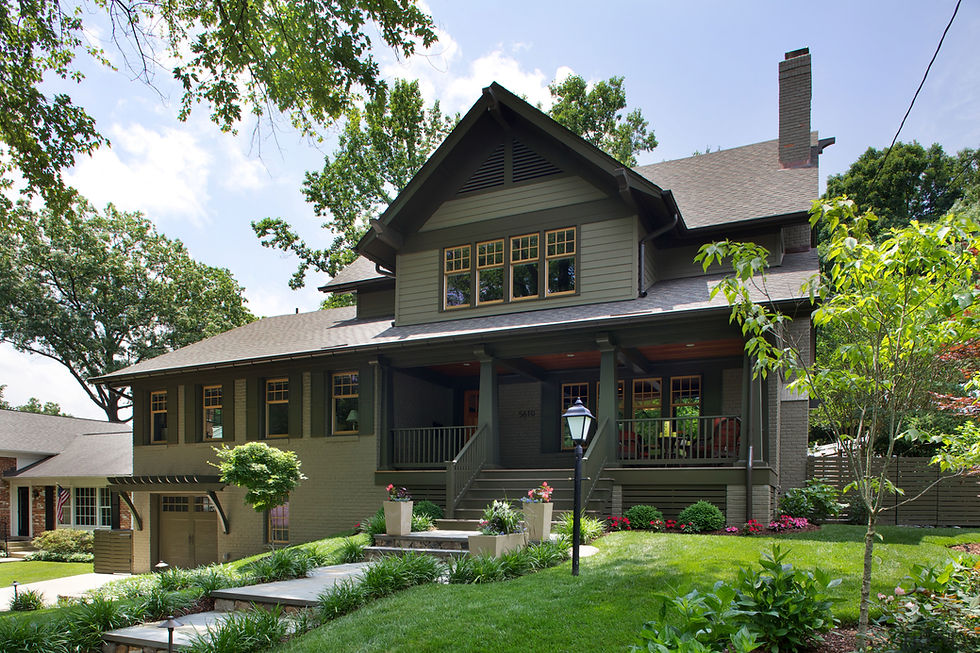Green House Black Trim
- Ramesh Chodhari
- Jun 18, 2023
- 3 min read

In recent years, the trend of combining bold exterior colors with contrasting trims has gained significant popularity in the realm of home design. One such captivating combination is a green house with black trim. This visually striking pairing not only enhances the aesthetic appeal of a property but also contributes to sustainable living.
Design Elements:
Exterior Colors:
The choice of a green hue for the house's main color brings a refreshing and natural vibe to the overall design. Shades of green like sage, olive, or moss can be used, depending on the desired aesthetic. Green promotes a sense of harmony and blends well with the surrounding environment.
Black Trim:
The black trim serves as a contrasting element, emphasizing architectural details and creating a visually striking effect. Black adds depth, sophistication, and a modern touch to the overall design. It creates a sharp contrast with the green backdrop, enhancing the overall curb appeal.
Material Selection:
When it comes to selecting materials, it is essential to prioritize sustainability. Opt for eco-friendly options like recycled or reclaimed wood, fiber cement, or composite materials for the trim. These materials not only offer durability but also minimize environmental impact.
Advantages of a Green House with Black Trim:
Aesthetics:
The combination of green and black creates a bold and eye-catching appearance, making the house stand out in the neighborhood. The contrasting colors draw attention to the architectural features, adding depth and character to the overall design.
Energy Efficiency:
Green houses are known for their energy-saving properties. The green color absorbs less heat from sunlight compared to darker colors, reducing the cooling load during hot seasons. The black trim, on the other hand, can act as a heat sink during colder months, absorbing and retaining solar heat.
Sustainable Appeal:
The use of sustainable materials for the black trim aligns with eco-conscious design principles. By incorporating recycled or reclaimed materials, homeowners can reduce the demand for new resources, contributing to a more sustainable construction industry.
Visual Harmony:
Green is often associated with nature, symbolizing growth, renewal, and tranquility. When combined with black, the color combination creates a harmonious and balanced aesthetic, connecting the house with its natural surroundings.
Environmental Benefits:
Reduced Carbon Footprint:
Constructing green houses and utilizing sustainable materials helps reduce the carbon footprint associated with conventional construction practices. By opting for eco-friendly options, homeowners can contribute to the mitigation of climate change.
Resource Conservation:
The use of recycled or reclaimed materials for the black trim helps minimize the extraction of new resources, preserving natural habitats and reducing waste generation. This promotes a more circular economy and a sustainable approach to construction.
What Is the Best Trim Color for a Green House?
The choice of trim color for a green house depends on several factors, including personal preference, the shade of green used for the house, architectural style, and surrounding landscape. Here are a few popular trim color options that can complement a green house:
White: White trim provides a classic and clean look that contrasts well with green. It creates a crisp and timeless appearance, particularly when paired with darker shades of green.
Cream or Off-White: Cream or off-white trim can add warmth and elegance to a green house. It creates a softer contrast than pure white and can work well with both light and dark shades of green.
Earth Tones: Earthy colors like beige, tan, or brown can harmonize with the natural environment and create a more subdued and organic aesthetic. These tones can complement various shades of green and blend well with the surrounding landscape.
Gray: Depending on the specific shade of green, gray trim can provide a sophisticated and contemporary look. Light gray shades can create a subtle contrast, while darker grays can add depth and richness to the overall color scheme.
Black: For a bold and dramatic contrast, black trim can make a green house stand out. It creates a striking effect, especially when used with lighter shades of green. Black trim can work particularly well in modern or minimalist architectural styles.
Should House Trim Be Lighter or Darker?
The choice of whether house trim should be lighter or darker largely depends on personal preference and the desired aesthetic outcome. Both lighter and darker trim can create different effects and impact the overall appearance of a house.
Lighter trim colors tend to create a contrast with the main color of the house and can make it stand out more prominently. Lighter trim can give a fresh and vibrant look to the exterior and can work well with houses that have darker main colors. It can also make the architectural details more visible.
On the other hand, darker trim colors can provide a sense of depth and richness to the exterior. Darker trim can create a more sophisticated and elegant look, especially when paired with lighter main colors. It can also make the house appear more grounded and substantial.



Comments